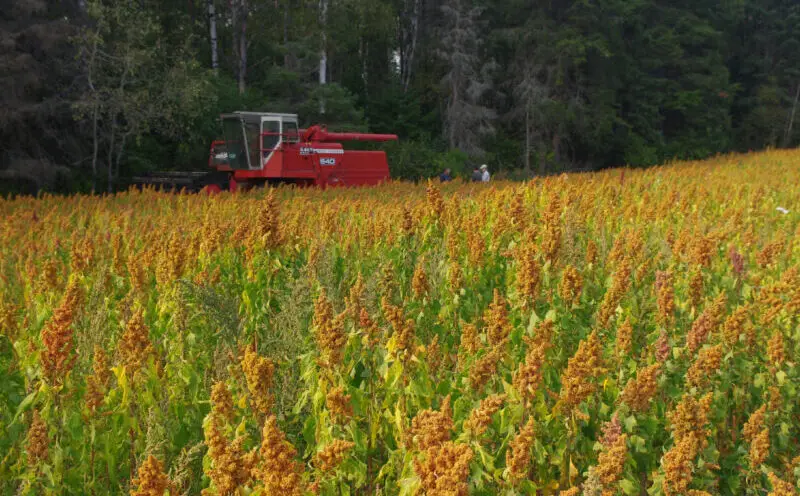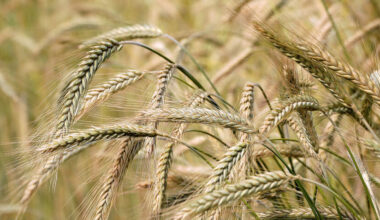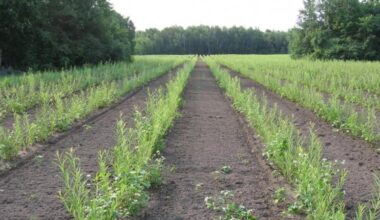As vegetarians know, quinoa is a plant with many virtues. In our climate, it is quite easy to cultivate this large flower whose tiny seeds, but also the leaves are edible. The most tedious part is the harvest…
In these times of questioning dogmas, it is not surprising that quinoa has the wind in its sails. Its richness in proteins makes it a possible alternative to meat consumption. The plant is gluten-free and its flour can therefore be used in the composition of preparations intended for intolerant people. Permaculturists like it because not only does it produce thousands of seeds, but its leaves are also edible.
Contents
Sowing quinoa
It is sown from the end of March to the beginning of April, under cover in a box. The emergence is capricious. Place the seed in the refrigerator for a week before using it. It needs to “store” cold to trigger germination.
As with tomatoes, transplant the seedlings at the two-leaf stage, one per cup. They are sensitive to slugs. Only when the seedlings reach 4 inches will you plant them in the garden. The seed can be found at seed stores, but organic seeds sold for consumption also germinate.
Planting quinoa
Once in the ground, quinoa does not require any special care. Excessive watering should be avoided, but watering during the summer when the plant is in bloom will help it to produce its flowers. Depending on the variety, the stems can measure from 22 inches to nearly two meters in height.
If they are sparsely arranged (26 inches apart in all directions), the tall stems are subject to lodging (they can bend in the wind or rain) and may need to be staked.
Where to plant quinoa?
Although growing quinoa in the garden is not yet a common practice, you can plant it without difficulty. For two months, it is very decorative, illuminating the garden with its colorful panicles.
Sow in a box or in a pot filled with potting soil, under unheated shelter.
In the open ground, sow under a tunnel. Plant in the sun, in well-prepared soil, enriched with compost, drained, cool and of neutral pH.
When to plant quinoa?
In March-April. Germination occurs quickly when the temperature is around 59°F.
How to plant quinoa?
Sow in a sheltered area, thin out, keeping 3 to 5 feet per m².
Cultivation and maintenance of quinoa
The recommended cultivation technique is the same as the one practiced by the Andean peoples: practice double transplanting.
Transplant the seedlings at 2 leaves, in individual cups. When the plants are 5 to 6 inches long, transplant them in their final place, spacing each plant 20 to 24 inches apart.
Water and mulch to keep the plants fresh and prevent unwanted weeds from growing.
Provide a stake for the tallest varieties.
No care is required afterwards, except for watering in case of drought.
Pests and diseases of quinoa
Quinoa is a fairly resistant vegetable plant, but it can be attacked by aphids (a mixture of water and black soap will get rid of them); it can also be sensitive to powdery mildew, a fungal disease that will affect it if its soil is too wet.
Harvesting quinoa
If the cultivation of quinoa is easy, its harvesting is a priesthood that can cool the stingy gardeners of their time. Indeed, it is necessary to dry the stalks during one month in the shelter of the rain before collecting the seeds by combing. Then comes the time of sifting and winnowing to separate the grain from the dried leaf residues.
Finally, since most varieties of quinoa contain saponin, a bitter substance that protects the seeds from the appetite of birds, it is necessary to wash and soak them several times in water. Eating quinoa is worth it!
When and how to harvest quinoa?
Quinoa is ripe when the seeds come off the inflorescences, in August or September.
Cut off the stalks and hang them upside down in a cool, dry and airy place, such as a cellar.
When the stalks are dry, beat them over a sheet to collect the seeds.
The conservation of quinoa
After harvesting, the seeds must be washed several times to remove the protective layer that contains saponins. This layer is unfit for consumption.
Those of the variety ‘Red faro’ originating from the south of Chile must soak several hours, washed several times then sifted to destroy this protective layer.
The varieties from ‘Dulce’ contain little or no saponins, so washing is less tedious: a good rinse is enough.
Leave them well spread out for a few hours in the sun, then store them in glass jars. Store the jars in a closed cupboard.
Store the seeds in envelopes until the following spring to sow them. Depending on the variety, one gram can contain from 400 to 700 seeds.
Uses of quinoa
If the cultivation of quinoa has exploded in recent years, it is because this plant can be grown in a variety of regions in terms of climate: indeed, quinoa is equally at home by the sea or in the mountains, in cooler or hotter areas, even arid. It can withstand temperatures ranging from 14°F to 104°F!
In the kitchen, quinoa is used as a cereal, and can perfectly replace semolina for example. Its seeds cook in 15 minutes in boiling water. With their light nutty taste, they complement lentils or mushrooms in particular. Their flavor and nutritional value make them recommended as a replacement for starchy foods in vegetarian diets.








